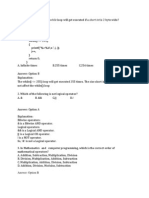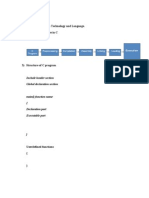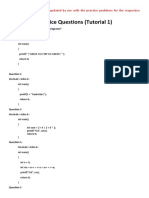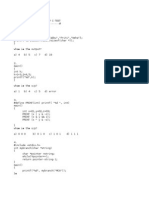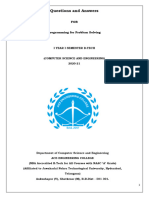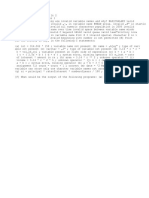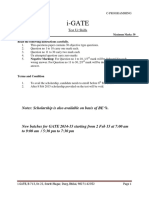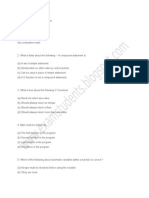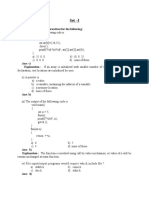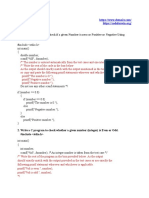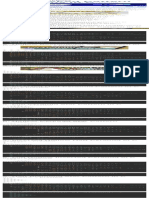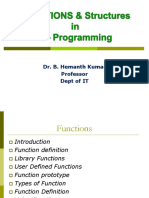Week 1 Questions
Sr. Question Options Answer & Explanation
no.
1 Find the output: A. 10 Answer: D
#include<stdio.h> B. 20
int main() C. 21 Explanation:
D. 11 x++ increments the value to 11.
{
So printf statement uses x=11.
int x=10; int y;
{
y=x++;
}
printf("%d",x);
}
2 Find the output: A. 97 Answer: A
#include<stdio.h> B. 98
int main() C. 99 Explanation:
{ D. ‘a’ The ASCII value of ‘a’ is 97
char c='a'; which gets switched while
switch(c){ switching the char c
case 97:
printf("97");
break;
case 98:
printf("98");
break;
case 99:
printf("99");
break;
default:
printf("default");
}
}
3 Find the output: A. 1,10 Answer: C
#include<stdio.h> B. 9,11
int main() C. 9,19 Explanation: The expression
{ D. 1,19 b*c+d-a gets evaluated first,
int x=10; which then sets the value of a
int a=1,b=2,c=3,d=4; to 9. This value is used for
x+=a=b*c+d-a; incrementing x.
printf("%d,%d",a,x);
}
4 Find the output: A. YES Answer: B
#include<stdio.h> B. NO
int main() C. Error Explanation:
{ int b = 1.1 assigns 1 to b.
float a=1.1; Comparing a==b compares 1
int b=1.1; with 1.1 which is FALSE.
if(a==b)
printf("YES");
else
printf("NO");
}
5 Find the output: 11 Answer: B
#include<stdio.h>
int main() Explanation:
{ The semicolon after the for loop
int i,x=10; terminates it and the brackets
for(i=0;i<2;i++); are treated as a single block,
{ thus x++ is executed only once.
x++;
}
printf("%d",x);
}
6 Find the output: 13 Answer: A
#include<stdio.h>
int main() Explanation:
{ Condition is evaluated to true
int i=-10; for any non-zero value. So, the
if(i){ first and last IF conditions are
printf("1"); evaluated as TRUE.
}
i=0;
if(i){
printf("2");
}
i=5;
if(i){
printf("3");
}
}
7 Find the output: A. 10 Answer: C
#include<stdio.h> B. 11
int main() C. 12 Explanation:
{ D. 13 The do loop executes once and
int x=10; E. The goes to the check. In the check,
do{ program runs for there is one more increment.
x++; more than 10 So the final answer is 12.
}while(x++>12); iterations.
printf("%d",x);
}
9 Find the output: A. 2 Answer: C
void main(){ B. 3 Explanation:
int a=22; C. 1 Right shift 4 times of 22 is
a=a>>4; D. 5 22/16 = 1 (integer division)
printf("%d",a);
}
10 Find the output: A. 7 Answer: A
void main(){ B. 8 Explanation:
int a,b; C. 6 , can also be used as an
a=3,1; D. Error operator and it has the least
precedence. So in the first
b=(5,4);
statement assignment is done
printf("%d",a+b);
first. In the second, assignment
}
is done later.
11 Which of the following condition A. a==10 Answer : C
checks will print 10 twice? B. a <= 10 Explanation : printf returns
C. printf("\n number of characters printed.
void main(){ %d",a) So the first 10 can be printed
int a=10; D. None of the using the condition. Since the
if(_______) above statement prints more than 0
printf("\n%d",a); characters, the IF condition is
else true and hence the IF part will
printf("\n%d %d",a,a); print one more 10.
}
12 #include<stdio.h> 9 Answer : B
main ( ) Answer :
{ 5 % (5 − 5/2 ) ∗ ( 5 −3)+5
int a=5; = 5 % ( 5 − 2 ) ∗ (5 − 3 ) +
int b = a % ( a−a /2 ) ∗ ( a 5
−3)+a; =5%3∗2+5
=2∗2+5
printf(”%d”,b);
=9
return 0 ;
}
14 #include<stdio.h> a. 1 a
b. 2 The precedence order is *, +,
int main(){ c. 4 >> and lastly +=
int i=1; d. 7 Therefore Ans = 1 + ((1
i += i*i>>2+3; *1)>>(2+3)) = 1 + ((1)>>(5)) =
printf("%d",i); 1+0 = 1
return 0;
}
Give the result of compiling and
running the above program?
15 #include<stdio.h> a. 15 c.
b. 24
int main(){ c. 33 The precedence order is *, +,
int i=1; d. 34 >> and lastly +=
i += i*i<<2+3; Therefore Ans = 1 + ((1
printf("%d",i); *1)<<(2+3)) = 1 + ((1)<<(5)) =
return 0; 1+32 = 33
}
Give the result of compiling and
running the above program?
16 char a,b,c; a. AABbCc c.
a = 'b'; b. AABbCc b = c => b = 'A'
b = 'c'; c. AABACA c = b => c = 'A'
c = 'A'; d. AcBbCA a = c => a = 'A'
b=c;c=b; c = a => c = 'A'
a=c;c=a;
printf("A%cB%cC%c",a,b,c);
What will be the output printed
by the printf statement?
Programming Question #1
Write a program to find the number of perfect squares between given two numbers A and B
(both inclusive). A number is called a perfect square if it can be written as x*x for some integer x.
Constraints:
Both A and B are positive. They both are less than 100,000.
Input: Two numbers A and B separated by a space
Output: Count of the number of perfect squares
Example 1:
Input: 3 10
Output: 2
Example 2:
Input: 16 70
Output: 5
Public Test cases:
Number Input Output
1. 3 10 2
2. 16 70 5
3. 11 99 6
Private Test cases:
Number Input Output
1. 1 100 10
2. 17 124 7
3. 12 1
4. 46 47 0
5. 10000 20000 42
Solution:
#include<stdio.h>
int main(){
int x,y,i,a;
int count=0,flag=0;
scanf("%d %d",&x,&y);
for(i=x;i<=y;i++){
for(a = 0; a <= i; a++)
{
if (i == a * a)
{
flag=1;
}
}
if(flag==1)
count++;
flag=0;
}
printf("%d",count);
return 1;
}
Programming Question #2
Write a program to find whether a given number (say x) is a “perfect number” or not.
Definition of Perfect number:
A perfect number is a positive integer that is equal to the sum of its proper positive divisors.
Explanation:
Take number 6.
Proper positive divisors of 6 is 1,2,3 and their sum is 1+2+3=6.
So, 6 is a perfect number.
Constraint:
x>=1
Input: A single number x
Output:
yes if given number x is a perfect number
no if given number x is not a perfect number
Example 1:
Input: 6
Output: yes
Example 2:
Input: 7
Output: no
Public Test cases:
Number Input Output
1. 6 yes
2. 10 no
3. 28 yes
Private Test cases:
Number Input Output
1. 1 no
2. 496 yes
3. 8128 yes
4. 1000 no
5. 4042 no
6. 33550336 yes
Solution:
#include<stdio.h>
int main(){
int x,i,sum=0;
scanf("%d",&x);
for(i=1;i<x;i++){
if(x%i==0){
sum+=i;
}
}
if(sum==x){
printf("yes");
}else{
printf("no");
}
return 1;
}
Programming Qn #3
Write a C program that takes a positive number N and produces an output that is the product of
its digits.
Explanation:
Take number 657.
Answer expected : 6 * 5 * 7 = 210
Constraint:
1<=N<=999999
Input: A single number
Output:
The value
Example 1:
Input: 657
Output: 210
Example 2:
Input: 7
Output: 7
Public Test cases:
Number Input Output
1. 657 210
2. 41 4
3. 931 27
Private Test cases:
Number Input Output
1. 1 1
2. 201 0
3. 1234 24
4. 5555 625
5. 10156 0
6. 999999 531441
7. 124356 720
8. 111111 1
Programming Qn #4
Given three points (x1, y1), (x2, y2) and (x3, y3) , write a program to check if all the
three points fall on one straight line.
INPUT:
Six integers x1, y1, x2, y2, x3, y3 separated by whitespace.
OUTPUT:
Print “Yes” if all the points fall on straight line, “No” otherwise.
CONSTRAINTS:
-1000 <= x1, y1, x2, y2, x3, y3 <= 1000
Public Test cases:
Number Input Output
1. 100030 Yes
2. -2 0 -2 1 -2 2 Yes
3. -62 14 -18 -23 -6 23 No




